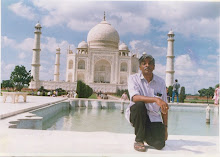Dear friends,
Water molecules carry unique fingerprints, based in part on differing proportions of the oxygen and hydrogen isotopes that constitute all water. Isotopes are forms of the same element that have variable numbers of neutrons in their nuclei.
Air, soil and water contain mostly oxygen 16 ( 16O). Oxygen 18 ( 18O) occurs in one oxygen atom in every five hundred and is a bit heavier than oxygen 16, it has two extra neutrons. From a simple energy standpoint this results in a preference for evaporating the lighter 16O containing water and leaving more of the 18O water behind in the liquid state. Thus seawater tends to be richer in 18O and rain and snow relatively depleted in 18O. Higher average global temperature would provide more energy and thus an increase in atmospheric 18O water. Lower than normal amounts of 18O in groundwater or an ice layer would imply that the water or ice represents an evaporation origin during cooler climatic eras or even ice ages.
Carbon 14 dating is also used as part of isotope hydrology as all natural water contains dissolved carbon dioxide.(inserted from Wikipedia)
Practical Isotope Hydrology is a book written by Dr SM Rao, retired Associate Director of Isotope Group, Babha Atomic Research Centre, Mumbai. This is a very concise book contains lot of information for students, Engineers, scientists and decision makers.
There are some excellent books on isotope hydrology but as the author itself puts in "The books do not appear to be readily usable by practicing hydrologists who may be looking for solutions to field problems. In this book an attempt is made to simplify the basic science concepts and focus on field applications...Hydrology is region specific.....Hence an attempt is made in this book to give as many Indian examples as possible"
This book is divided into five chapters and the first chapter deals with what isotope hydrology is all about and why should isotope methods be used. It starts with a description of isotope characteristics as well as their relevance as tracers in studies on various stages of the hydrological cycle. The second chapter deals with basis for applications of various isotopes in hydrology. Through this chapter the author illustrates applications of both environmental isotopes and injected tracers. Third chapter deals with isotope applications in surface water hydrology. In this chapter the author depicts stream flow measurement, lake dynamics, percolation tank hydrology, seepages from dams, reservoirs and from canals. The fourth chapter is about isotope applications in groundwater hydrology. In this chapter in view of the importance of identification of ground water recharge and recharge process, due emphasis is given to this aspect of application of environmental isotopes. Role of isotopes in understanding rate of soil moisture transport in unsaturated zone, saturated zone, seawater intrusion, ground water contamination from natural pollutants like inland salinity, arsenic and nitrate is also discussed with examples. In the concluding fifth chapter the author discusses the need for enhanced application of isotope hydrology and how it can be achieved.
When Dr K Vasu, Scientist, W M(A) Division, initiated actions to develop Radiotracer laboratory in CWRDM with the constant pursuance of Dr V K Vamadevan, Head, Water anagement Agri. Division, it was Dr SM Rao who gave continued support in establishing Radiotracer Laboratory and later its up-gradation to Isotope Hydrology Division.
I am sure that this book will be a boon for beginners as well as professionals in the field of Isotope Hydrology.

No comments:
Post a Comment